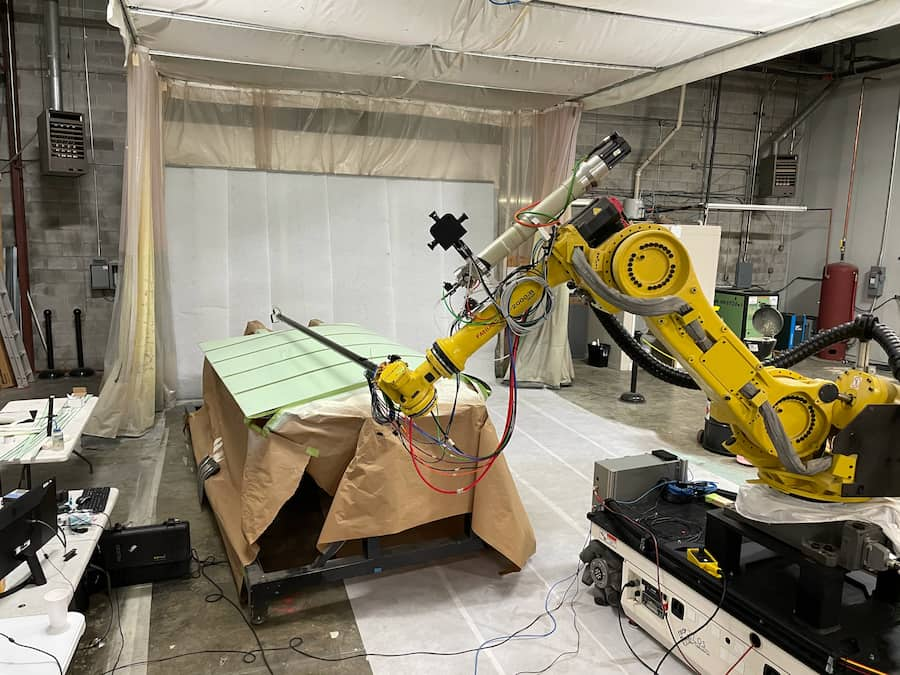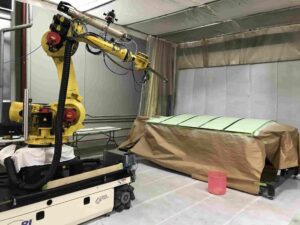Video from the final project demonstration.
Autonomous Aircraft Coating Project Team
Lockheed Martin Corporation (Principal Investigator), Aerobotix, and Southwest Research Institute (SwRI)
Autonomous Aircraft Coating Background
 The Mobile Autonomous Coating Application For Aircraft Sustainment Project was funded as a result of our collaboration with the JROBOT (Joint Robotics Organization for Building Organic Technologies) Group as part of the Joint Summit: Robotics in Sustainment II event. The JROBOT group is a Department of Defense (D0D) task force created to leverage investments in research and development between U.S. Government and partners to harness advancements in robotic technology for sustainment and maintenance efforts. The ARM Institute continues to collaborate closely with the JROBOT Group to spur important sustainment-focused robotic solutions.
The Mobile Autonomous Coating Application For Aircraft Sustainment Project was funded as a result of our collaboration with the JROBOT (Joint Robotics Organization for Building Organic Technologies) Group as part of the Joint Summit: Robotics in Sustainment II event. The JROBOT group is a Department of Defense (D0D) task force created to leverage investments in research and development between U.S. Government and partners to harness advancements in robotic technology for sustainment and maintenance efforts. The ARM Institute continues to collaborate closely with the JROBOT Group to spur important sustainment-focused robotic solutions.
On June 29, 2021 at Aerobotix’s facility in Huntsville, AL, the robotics project team successfully demonstrated a mobile robotic base with an industrial robotic arm capable of accurately painting large aircraft components without time consuming re-programming, costly fixturing, or a purpose-built static coating facility. By leveraging commercially off the shelf (COTS) hardware and autonomous scan and plan technology, the team successfully demonstrated an autonomous aircraft coating system capable of producing significantly better results than a human operator and comparable to a purpose-built robotic coating system.
Autonomous Aircraft Coating Problem Statement
Over the past decade, robotics solutions have been commonly integrated into aerospace manufacturing processes as a method to lower production costs and increase product quality. Though advancements have been made, automated systems in aerospace production environments still tend to be purpose-built solutions dedicated to specific tasks that require expert programmers to manage the system software. Additionally, production automated systems require significant facility capital investments and a high production throughput to achieve a positive return-on-investment.
Typical solutions for robotic coating applications require a work-cell with multi-axis robots operating across multi-axis rails or tracks. This automated method provides significantly improved solutions over manual coating applications within production but is designed to meet specific aerospace manufacturer program requirements in a stationary location. Following product delivery to the field and eventual maintenance operations, sustainment maintainers are required to resort to legacy manual methods for coating application. Manual coating application is a tedious task, often requiring multiple maintainers across multiple shifts and is difficult to produce the same level of quality as seen in production. Though advancements have been made for robotic coating application within production, sustainment coating application methods have remained stagnant even as Department of Defense (DoD) aircraft fleets increase and aircraft become more advanced with stringent finishes requirements.
Autonomous Aircraft Coating Approach
This AI and robotics project team leveraged a combination of Commercial Off The Shelf (COT) hardware that has been previously demonstrated for past DoD research efforts and developments specific to this project effort.
As part of the project, the team developed and demonstrated the following:
- Robotic end-effector capable of servicing multiple coating applications
- Automated coating application parameters (e.g., standoff, thickness, flow rate, etc.)
- Mobile system to robotically apply coatings to aircraft representative part
- Inspection parameters for quality acceptance (e.g., visual, thickness, etc.)
- Robotic path plan software for autonomous mobile system movement
Autonomous Aircraft Coating Results
As the variety, size, and complexity of aerospace platforms continues to increase, the sustainment community is faced with having to stand up specialized pre-programmed robotic systems. This is an extremely expensive and daunting ask unsuitable for most environments. An agile approach to robotic spray operations is needed to provide the sustainment community the flexibility necessary to meet its mission requirements.
Outputs from the Mobile Autonomous Coating Application For Aircraft Sustainment Project include:
- 50% increase first pass yield/quality and reduced rework per aircraft (e.g., fighter aircraft parts coating)
- Enabled 3x throughput increase per part by minimizing corrective action (e.g., respray/sanding)
- Reduced facility capital investments by 6x, leveraging mobile solution vs. hard tooling
- Platform and task agnostic system, applicable across multiple programs
Autonomous Aircraft Coating Impact for the Department of Defense (DoD):
 The automation of painting and the application of advanced coatings is high priority for the DoD. The Mobile Autonomous Coating Application System for Sustainment project directly addresses some of the key robotic capabilities that resolve several of the critical needs towards achieving autonomous mobile multi-agent robotic spray systems that are capable of painting large, complex and eventually complete aircraft.
The automation of painting and the application of advanced coatings is high priority for the DoD. The Mobile Autonomous Coating Application System for Sustainment project directly addresses some of the key robotic capabilities that resolve several of the critical needs towards achieving autonomous mobile multi-agent robotic spray systems that are capable of painting large, complex and eventually complete aircraft.
The ARM Institute, in collaboration with the project team, was able to demonstrate the program’s results to more than 75 individuals representing over 20 organizations during the final hybrid out-brief and live demonstration. A broad Department of Defense (DoD) participation included: AFRL ManTech, WR-ALC, OO-ACL (F-22), Hill AFB, Naval Undersea Warfare Center, ONR, USMC Logistics Command. Industry representatives included LMCO Corporate Technology, Skunkworks, F-22, F-35; ABX, SwRI, Spirit AeroSystems, Wichita State, and more.
Next Steps
The project outputs have considerable impact for the ARM Institute, the institute’s membership, and the Department of Defense. The ARM Institute, in partnership with the DoD, is pursuing continued development efforts for this project.
A key benefit of ARM Institute funded projects is the ability to improve the state of the practice, while identifying challenges that have the potential for considerable improvements. The following recommendations were presented by the project team for possible future development programs:
- Paint “stitching” to prevent checkerboard appearance,
- Avoid hard cure lines during repositioning/scanning activities,
- C1D1 hardware requirements/design considerations
- Tool path generation across complex (contoured) geometries and/or confined spaces,
- Safety systems necessary to allow operators in same booth/work area as robotic system,
- Multi-robot/system integration or collision prevention integration,
- Refined and improved user interface for operators,
- Simultaneous platform movement with spray operations,
- Initial surface detection is critical to overall system performance, alternate methods/data may be possible to supplement sensor detection.
The ARM Institute’s Role
“Engaging with the ARM Institute provided the team an opportunity to develop and demonstrate an innovative robotic capability that can be expanded to meet the needs of our Department of Defense (DoD) customers. The ARM Institute facilitated a partnership with our DoD Sustainment Technical Advisors and helped guide a prototype solution that advances the DoD mission for robotics in sustainment. This effort demonstrated a disruptive capability and significant opportunity for the sustainment community in the future.” – Lockheed Martin
ABOUT THE ARM INSTITUTE
Advanced Robotics for Manufacturing (ARM) is a Manufacturing Innovation Institute (MII) funded by the Office of the Secretary of Defense under Agreement Number W911NF-17-3-0004, and part of the Manufacturing USA® network. The ARM Institute leverages a unique, robust, and diverse ecosystem of consortium members and partners across industry, academia, and government to make robotics, autonomy, and artificial intelligence more accessible to U.S. manufacturers large and small, train and empower the manufacturing workforce, strengthen our economy and global competitiveness, and elevate national security and resilience. Based in Pittsburgh, PA since 2017, the ARM Institute is leading the way to a future where people & robots work together to respond to our nation’s greatest challenges and to produce the world’s most desired products. For more information, visit www.arminstitute.org and follow the ARM Institute on LinkedIn and Twitter.
